The Hitachi HUSSL4010BSS600 100GB we are benchmarking today is a relatively small SSD by current standards. It only has 100GB of capacity but it is meant for high end applications. Onboard this SAS2 drive is SLC NAND and the drive is capable of 9PB of writes or approximately 9,000-10,000 full disk writes given its 100GB size and 93.16GB formatted capacity. When setting the comparison group we tried to pick SSDs that we have tested that are likewise meant for higher write endurance and that have lower capacities. What we found was quite shocking. Unlike other vendors where the smaller models exhibited significantly lower performance, the Hitachi HUSSL4010BSS600 100GB SLC drive performed extremely well.
Test Configuration
Since we are going to assume the use of already released hardware, we are using a legacy system for testing across the test suite:
- Motherboard: Gigabyte GA-7PESH3
- Processors: Dual Intel Xeon E5-2690 (V2)
- SAS Controller: LSI SAS 3008
- RAM: 64GB DDR3L-1600MHz ECC RDIMMs
- OS SSD: Kingston V300 240GB
We are using a SAS controller so one cannot compare our SATA results directly to consumer-driven setups where a SATA SSD is connected to an Intel PCH port. There is a latency penalty for going over the PCIe bus to a controller to SAS. It also is a reason NVMe is going to be a game changer in the enterprise storage space.
Hitachi HUSSL4010BSS600 100GB SSD Quick Benchmarks
For our quick tests during this part of the series we will just provide the quick benchmarks with only a bit of commentary. The results should be fairly straightforward and we have added a few results for comparison purposes.
AS SSD Benchmark
AS SSD is a solid benchmark that does not write compressible data to drives. The result is perhaps one of the best workstation SSD benchmarks available today.
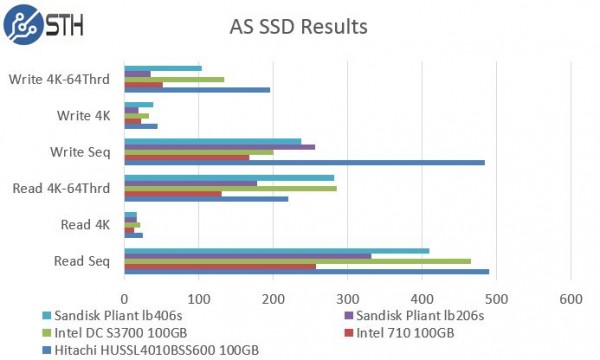
Here we can see nothing short of complete domination by the Hitachi SLC drive. The SanDisk/ Pliant lb206s and lb406 are 200GB and 400GB SAS2 SLC SSDs also and they have no chance of keeping up, even at larger capacities. Note, the huge drop-off of the lb206s to the lb406s in our charts. The lower capacity Hitachi drive seems to perform well even given its smaller amount of NAND.
CrystalDiskMark
CrystalDiskMark is another benchmark which gives non-compressible read/write numbers. This is in contrast to the ATTO Benchmark used by LSI/ Sandforce and its partners when they market a given solid state drive.
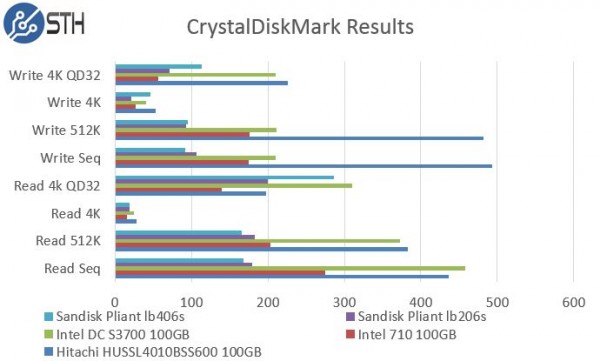
In CDM we can see the Intel S3700 100GB drive pull ahead in both the 4K QD32 read test and the sequential read test. When it comes to write, no other drive, including the SanDisk Lightning SLC drives can even manage half of the sequential write performance of the 100GB SLC Hitachi drive.
ATTO Benchmark
The value of the ATTO benchmark is really to show the best-case scenario. ATTO is known to write highly compressible data to drives, which inflates speeds of controllers that compress data like LSI/ SandForce does prior to writing on a given solid state drive.
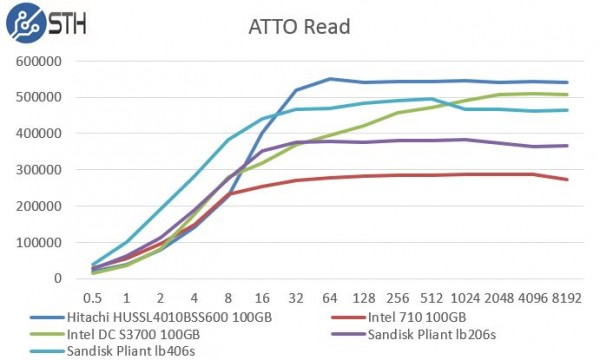
On the read side, we can see that each drive has a fairly distinct curve. The Intel 710 100GB is limited by the SATA II interface, and is just there as a 3gbps data point. We can see though that after 16k, the Hitachi drive has a comfortable lead our ATTO read tests.
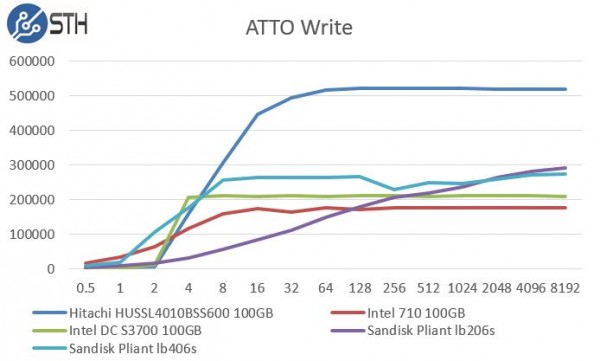
On the write side, by 8k the Hitachi HUSSL4010BSS600 100GB SLC drive completely dominates the competition.
Conclusion
The benchmarks speak for themselves. The Intel-Hitachi collaboration that produces these drives has absolutely stunning results. With excellent performance, 9PBW over five years and a 0.44% AFR, these drives are built to be fast and reliable. This also means that the drives cost a bit more, however Hitachi and Intel’s collaboration on these SAS2 drives provide results far superior to either Intel’s high-end SATA offerings or competitive SAS2 SLC SSDs.

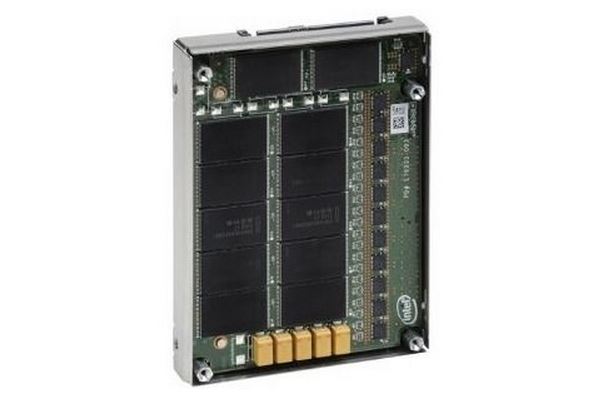


I had no idea about these Hitachi drives being so fast. #blownaway